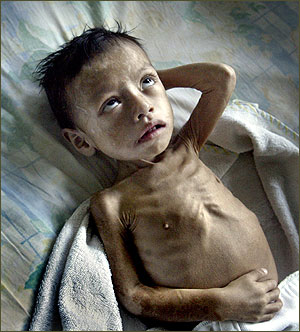
Ishaal Zehra
A 27 year-old Russian man, Sergei Gavrilov, killed his 55 year-old mother because she refused to give him her pension money so he could go for gambling and partying. He was so infuriated that he smashed her head with a brick and then strangled her. He put her out on the balcony, spent the next 2 weeks blowing through her money, and then when he discovered her body had frozen, he cannibalized her dead body, making soup and pasta from parts of her legs for over a month.
‘She was frozen, like meat in the freezer,’ he told police.
Apparently he was driven to eat his own mother’s flesh because he was starving. Or at least that’s what he claimed.
The whole story flashed in my mind while reading the latest United Nation’s Children’s Fund report that said India has the largest number of stunted children below the age of 5 in the world.
More than 90 percent of the developing world’s children facing stunted growth live in Africa and Asia, the report said. One third of them — roughly 60.8 million — are in India alone. Out of a total of 19 million newborns per year in the developing world that are born with low birth-weight, India avow the 7.4 million low birth-weight babies per year — the highest in the world.
The report said that “more than half of the world’s chronically undernourished children under the age of 5 live in South Asia. The rates were highest in Bangladesh, India, Timor-Leste and Yemen, comprising more than 40 per cent of underweight children.
India has one of the highest numbers of underweight children, below the age of five– in the world in addition to one third of ‘wasted children’ (those facing a greater chance of death). Undernourished children often have poor physical health and slower mental development. When the problem is widespread, as in India and Afghanistan, it undermines those countries’ ability to improve their economies and eradicate poverty.
In developing countries, almost 200 million children under the age of 5 suffer from stunted growth and health problems due to poor nutrition in their early years. Those who survive under-nutrition often suffer poorer physical health throughout their lives, and damaged cognitive abilities that limit their capacity to learn and to earn a decent income,” the UNICEF chief said. “They become trapped in an intergenerational cycle of ill-health and poverty,” she added.
Leaving aside the future of India, the present of India is even in the worse condition. According to another report, India is fast emerging as the Hunger Capital of the world.
As per the report released by Navdanya Trust, India is fast emerging as the hunger capital of the world with one in every four Indians going hungry. If this is any indication of an impending food crisis, the report said that 57 million children in India, the largest in the world, are underweight due to malnutrition. Although the Indian central government spends more than Rs. 32,600 crores in food subsidies, per capita food consumption has reduced from 186 kg per person annually in 1991 to 152 kg in 2001 and is gradually on the decrease.
The report said, “The food prices have doubled since 2003 and if the food prices continue to rise, the situation is not going to get any better. The report also criticized the quality of food provided at ration shops and cited genetically modified seeds and chemicals as the reason for the high cost of food production, forcing farmers to debt and ultimately suicide. The report further said that the proposed Food Security Act, based on a failed policy was only adding insult to the injury.
Most people in New Delhi are concerned about poverty situation in India and general discriminatory behaviour amongst Indians, where, a number of them were of the view that India has adopted a policy to focus and develop select group of Indian high society and bring it at par with the developed world and then take on the next segment of society for its development. As most military diplomats believed that even if India attempts to take the entire population along, still it will not be able to match the pace of progress and will be thus left behind. They have taken a sharp decision indeed as why to carry the deadlock with one. But this is not a deadlock rather a huge portion of their own population.
Many congratulations to the Indian cream of the crop on the successful launch of Dhanush, the 350 km range ship based anti-surface missile from INS Subhadra in the Bay of Bengal on December 14. This was probably the consolation after the failure of its nuclear-capable IRBM (Intermediate Range Ballistic Missile) Agni-III in May and November 2009 test firings. Furthermore the nuclear deals with the West are on the surge already, what if it’s on the cost of India’s inopportune poor masses.
A 60.8 million of Indian children with stunted growth with one in every four Indians going to death due to hunger is not easy to digest. It is a big figure to ignore. Probably, most people are very much right to believe that India has a gigantic task to lift the masses out of poverty which seems very unlikely under the prevailing corrupt and inefficient Indian society as a whole. Don’t you think it would be better to snub that farce slogan of shining India and accept the reality with facts? The money been wasted on expanding nuclear arsenals and guns and missiles budget rather be spend on helping the massive rock bottom poverty. Or else, am afraid many of “Sergei Gavrilov” would be forced to turn cannibal with no other option left for survival. It is a serious snag, provided someone pay any heed to it.



